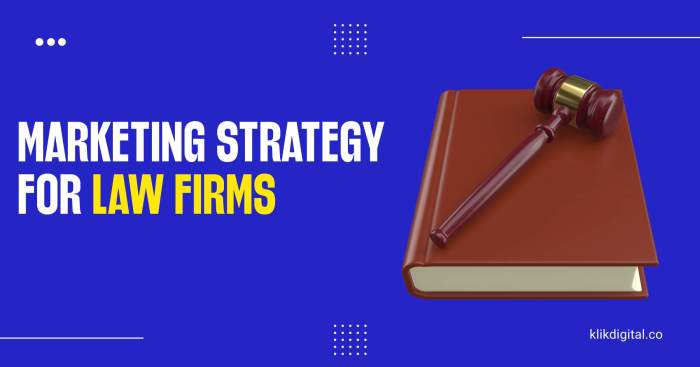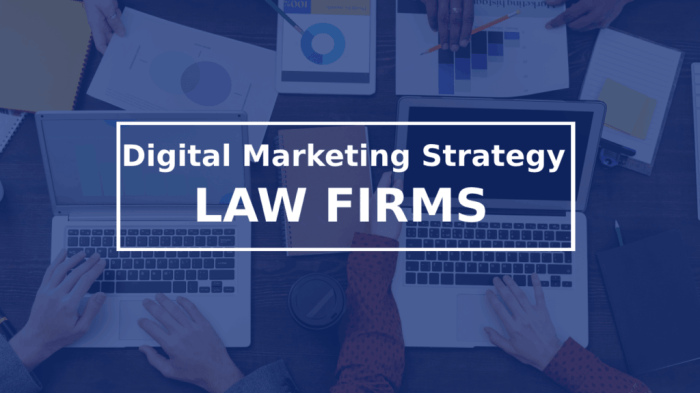Embarking on the journey of crafting a successful internet marketing strategy for law firms in 2025 involves navigating through a landscape of challenges and opportunities. By understanding the key elements and trends, setting clear goals, establishing a robust online presence, leveraging social media, implementing paid advertising, and monitoring performance, law firms can position themselves for success in the digital realm.
Understanding the Landscape
In order to build a successful internet marketing strategy for law firms in 2025, it is crucial to first understand the current landscape of internet marketing for the legal industry. This involves researching the latest trends, identifying key challenges and opportunities, and comparing traditional marketing strategies with digital approaches.
Current Trends in Internet Marketing for Law Firms
- Increased focus on content marketing to establish thought leadership and build trust with potential clients.
- Rise of video content as a powerful tool for engaging audiences and explaining complex legal concepts.
- Growth of mobile marketing strategies to reach clients on-the-go.
- Utilization of social media platforms for brand awareness and client engagement.
Key Challenges and Opportunities in the Industry
-
One of the main challenges is standing out in a crowded digital space and differentiating your firm from competitors.
-
Opportunities lie in leveraging data analytics to optimize marketing campaigns and target the right audience effectively.
-
Adapting to changing algorithms and technology to ensure your online presence remains competitive is another challenge to be addressed.
Comparison of Traditional vs. Internet Marketing for Law Firms
- Traditional marketing relies heavily on print ads, billboards, and TV commercials, while internet marketing focuses on , PPC advertising, and social media.
- Internet marketing allows for more targeted and measurable campaigns, whereas traditional marketing can be harder to track ROI.
- Cost-effectiveness and wider reach are advantages of internet marketing, while traditional marketing can be more costly and limited in scope.
Defining Goals and Objectives
In order to build a successful internet marketing strategy for law firms in 2025, it is crucial to clearly define the goals and objectives that need to be achieved. These goals will serve as a roadmap for the marketing efforts and help in measuring the success of the strategy.
Specific Goals for the Internet Marketing Strategy
- Increasing online visibility and brand awareness.
- Generating more leads and inquiries through digital channels.
- Establishing thought leadership in the legal industry.
- Improving client retention and satisfaction.
- Enhancing online reputation and credibility.
Identifying Target Audiences and Their Needs
- Identify the specific target audience for the law firm's services, such as individuals in need of legal assistance, businesses seeking legal advice, or other law firms for collaboration.
- Understand the needs and pain points of the target audience to tailor the marketing messages and content accordingly.
- Segment the audience based on demographics, behavior, and preferences to create personalized marketing campaigns.
Aligning Marketing Goals with Business Objectives
- Ensure that the marketing goals align with the overall business objectives of the law firm, such as revenue growth, client acquisition, or expansion into new practice areas.
- Define key performance indicators (KPIs) to measure the success of the marketing strategy, such as website traffic, conversion rates, and return on investment (ROI).
- Regularly review and adjust the marketing goals and tactics based on the performance metrics to optimize the strategy for maximum results.
Creating a Strong Online Presence
Building a strong online presence is crucial for law firms in 2025 to attract potential clients and establish credibility in the digital landscape.Discuss the importance of search engine optimization () for visibility: plays a vital role in ensuring that your law firm's website ranks high on search engine results pages.
By optimizing your website with relevant s, meta tags, and quality content, you can increase visibility and attract organic traffic.Explore strategies for content creation and distribution:Creating high-quality content is essential for engaging with your target audience and showcasing your expertise in the legal field.
Consider starting a blog where you can share valuable insights, legal updates, and case studies. Additionally, producing informative articles and videos can help you connect with potential clients on different platforms.
Design a User-friendly Website
When designing your law firm's website, prioritize user experience and ensure that it reflects your firm's image professionally. Implement a clean and intuitive layout, easy navigation, and mobile responsiveness to provide visitors with a seamless browsing experience.
Utilize Social Media Platforms
Engage with your audience on social media platforms like LinkedIn, Twitter, and Facebook to expand your reach and connect with potential clients. Share your blog posts, articles, and videos to increase visibility and establish your firm as a thought leader in the legal industry.
Implement Local Strategies
Optimize your website for local search by including location-specific s, creating Google My Business listings, and obtaining positive reviews from satisfied clients. This will help your law firm appear in local search results and attract clients in your area.
Leveraging Social Media

In today's digital age, social media has become a powerful tool for law firms to connect with their target audience, build brand awareness, and establish credibility. By leveraging social media effectively, law firms can reach a wider audience and drive engagement.
Identifying Relevant Social Media Platforms
- LinkedIn: Ideal for B2B networking and showcasing expertise in legal matters.
- Twitter: Great for sharing quick updates, legal news, and engaging with followers.
- Facebook: Useful for creating a community, sharing informative content, and engaging with a broader audience.
- Instagram: Visual platform for showcasing the human side of the firm, behind-the-scenes glimpses, and attorney profiles.
Engaging with the Audience Through Social Media
- Respond promptly to comments and messages to show that you value your audience's feedback.
- Share informative and relevant content that addresses common legal questions or current legal issues.
- Host live Q&A sessions or webinars to engage directly with your audience and showcase your expertise.
- Use polls, surveys, and interactive content to encourage audience participation.
Creating Compelling Social Media Content
- Utilize visually appealing graphics, videos, and infographics to grab attention and convey information effectively.
- Share success stories, client testimonials, and case studies to demonstrate your firm's capabilities and results.
- Utilize hashtags strategically to increase visibility and reach a wider audience interested in legal topics.
- Establish a consistent posting schedule to maintain engagement and keep your audience informed.
Implementing Paid Advertising

Implementing paid advertising is a crucial aspect of any successful internet marketing strategy for law firms. By investing in paid ads, you can reach a larger audience and drive more traffic to your website. In this section, we will compare different paid advertising options, discuss budgeting and targeting strategies, and share tips for optimizing paid advertising campaigns for maximum ROI.
Comparing Paid Advertising Options
- Google Ads: Google Ads, formerly known as Google AdWords, is a popular choice for paid advertising. It allows you to create text, display, and video ads that appear on Google search results and other websites within the Google Display Network.
- Social Media Ads: Platforms like Facebook, Instagram, LinkedIn, and Twitter offer paid advertising options that allow you to target specific demographics, interests, and behaviors.
Budgeting and Targeting Strategies
- Set a realistic budget based on your goals and the average cost per click (CPC) for your target s.
- Use targeting options such as location, demographics, interests, and s to reach your ideal audience.
- Monitor your campaigns regularly and adjust your budget and targeting strategies based on performance data.
Optimizing Paid Advertising Campaigns
- Create compelling ad copy that highlights your unique selling points and encourages users to take action.
- Use A/B testing to experiment with different ad creatives, headlines, and calls-to-action to optimize performance.
- Implement conversion tracking to measure the effectiveness of your campaigns and make data-driven decisions.
- Consider retargeting campaigns to reach users who have previously visited your website but did not convert.
Monitoring and Analyzing Performance
Monitoring and analyzing the performance of your internet marketing strategy is crucial for determining its effectiveness and making necessary adjustments to optimize results. By identifying key performance indicators (KPIs), utilizing the right tools and techniques, and interpreting data correctly, you can make informed decisions to enhance your online presence and reach your goals.
Identifying Key Performance Indicators (KPIs)
- Website Traffic: Measure the number of visitors to your site and track trends over time.
- Conversion Rate: Monitor the percentage of visitors who take a desired action, such as filling out a contact form or requesting a consultation.
- Click-Through Rate (CTR): Evaluate the effectiveness of your ads and content by measuring the percentage of users who click on them.
- Social Media Engagement: Analyze likes, shares, comments, and other interactions on your social media platforms to gauge audience engagement.
Tools and Techniques for Monitoring Performance
- Google Analytics: Utilize this powerful tool to track website traffic, user behavior, conversion rates, and more.
- Tools: Monitor rankings, backlinks, and other metrics to improve your search engine visibility.
- Social Media Analytics: Use platform-specific analytics tools to track engagement, reach, and other social media metrics.
- A/B Testing: Conduct experiments to compare different versions of your website, ads, or content to determine which performs better.
Interpreting Data and Making Data-Driven Decisions
- Identify Trends: Look for patterns in your data to identify what is working well and what needs improvement.
- Set Benchmarks: Establish goals and benchmarks to measure progress and determine the success of your marketing efforts.
- Optimize Performance: Use insights from data analysis to make informed decisions on where to allocate resources for maximum impact.
- Continuous Monitoring: Regularly review performance metrics and make adjustments as needed to keep your strategy on track.
Final Review
In conclusion, building a successful internet marketing strategy for law firms in 2025 requires a strategic approach that integrates various elements such as online presence, social media engagement, paid advertising, and performance monitoring. By staying ahead of trends and adapting to the evolving digital landscape, law firms can establish a strong foothold and reach their target audience effectively.
Commonly Asked Questions
How can I research current trends in internet marketing for law firms?
To research current trends, you can follow industry publications, attend relevant webinars or conferences, and analyze competitor strategies.
What are some key performance indicators (KPIs) for measuring success in internet marketing?
Some common KPIs include website traffic, conversion rates, click-through rates, and social media engagement metrics.
How can a law firm align its marketing goals with overall business objectives?
Aligning marketing goals with business objectives involves understanding the firm's unique value proposition, target audience needs, and desired brand image.







